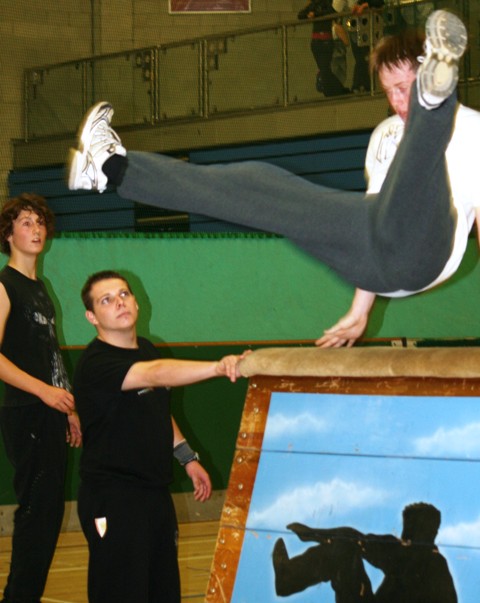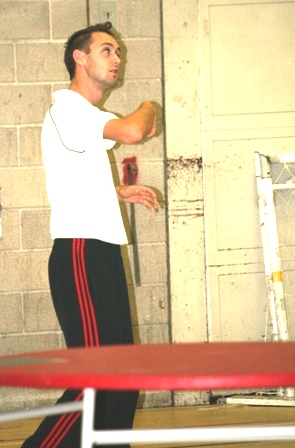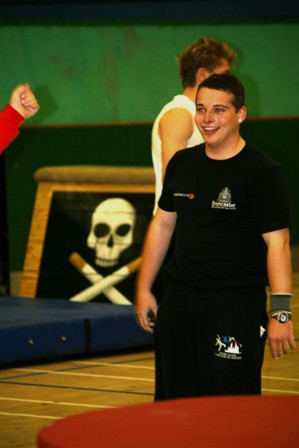
Another challenge on the well-sprung mean streets
Parkour? Pourquoi pas?
The government, or parts of it, might favour competitive sport but PE teachers, school sports partnerships and, more importantly, young people are far more keen on alternative forms of physical activity. The Leisure Review took a run at parkour, a street activity with its eyes on the mainstream.

Another challenge on the well-sprung mean streets
Parkour is not free running. Nor is it freestyle gymnastics. Nor is it a sport. Some call it an art, others a discipline, others a philosophy. To explain its inexplicability it is necessary to go back to parkour’s roots in France where, called the Art du Deplacement, it was developed from African and Far Eastern roots by a second-generation traceur, David Belle. Influenced by his father’s experiences as a firefighter in Paris, the teenaged Belle joined a commune in Lisses and developed a way of moving around the built environment which tested the mind as well as the body. Efficiency, grace and speed were valued, going back on yourself frowned upon, and ‘tricking’ and competition abhorred.
When the movement crossed the Channel, and indeed the Atlantic, there was a very French refusal to countenance Anglicisation and, as ‘parkour’ became ‘free running’, a schism was born which commercialism and the viral nature of youth culture has done little to mend. Parkour is a burgeoning business with its own magazines, kit suppliers, bespoke equipment manufacturers and training companies. It even has a national governing body (NGB). Along the way some of the purity has been lost and distinctions have been blurred but on the streets and, perhaps more pragmatically in school gyms and local authority sports halls, young people are performing cats, diving kongs and crane wallhops in increasing numbers.
In Doncaster the Flying High school sport partnership (SSP) led by partnership development manager Lindsy Gray has embraced parkour as part of their alternative offer to young people. “We try to help young people who really want to do something active but feel themselves shut out of traditional sports because they don’t have that set of skills,” she said. “We have coaches, particularly Graeme Severn, our alternative activities officer, who listen to what the young people say they want to try and then use their excellent coaching skills to deliver what the young people actually want. When we introduce something out of the ordinary, like parkour, tchoukball or dodgeball, everyone is on a level playing field.”
This attitude has proved particularly successful in parkour with sessions at every secondary school feeding into an academy held at the Doncaster Dome. When The Leisure Review visited the academy over 50 young men and women were queuing patiently to hurl themselves over a limited number of pieces of standard gym equipment. A beginners’ session was being coached by Flying High’s young people’s officer, Craig Collins, while a mixture of young leaders and workers from partner organisation Positive Futures managed the rest of the group.
Collins is a Level 1 parkour coach with his eyes on his Level 2 and the young leaders have all been trained to assist him. There is little evidence of risky behaviour and, although some of the moves are breathtaking in their effect and all the young people are clearly responding to a challenge to better their performance, the sense of the session is that the challenge comes from within and the coaches’ role is to engender self-reflection, self-reliance and self-respect rather than macho posturing and inappropriate competition.
We asked Gray how this had all come about. “We have parkour sessions in all of the secondary schools in our partnership,” she said, “and those who want to can come here once a week. There is a real range from very experienced, unique individuals to the beginners who are always coming through. We need more coaching time to work with newer participants so we have a parkour leadership team of young people who have been involved for a long time and who come and volunteer at the academy supported by our qualified coaches.”
The work done outside schools and certainly outwith the standard PE curriculum is raising questions about what happens in mainstream lessons. “We have found that extra-curricular provision has moved in such a different direction that we are beginning to consider physical education lessons in terms of the kind of activity that is being offered,” Gray said. “If we are engaging young people outside of the curriculum, and that’s where their interests are, shouldn’t we be engaging them when we have them in PE time?”
To achieve this Gray is conscious of the need to provide resources and expertise, and has been working within the partnership to develop Key Stage 3 and 4 parkour resources for teachers. “We started the process a year ago to help some of the schools in a particularly deprived part of Doncaster where there was virtually no extra-curricular provision. Headteachers were saying, ‘We’ve got kids jumping off the roofs and swinging off things and, while they are doing amazing things, we do have a concern for health and safety.’ So we decided to try to nurture their talent in a positive fashion and teach them about safety, respect for property and respect for each other as part of the package. We got 30 to 40 students in the smallest, oldest gym using the most beat-up equipment and the PE department said they had never seen those faces at extra-curricular activities before. We then told schools that we were not going to provide this service for free and when all the schools bought in we moved forward and recruited an educational consultant with experience of writing physical education schemes, Sharon Robinson.”
Robinson then wrote a resource that delivered curriculum outcomes but through the theme of parkour. It was, Gray explained, “similar to gymnastics but with a different slant and far more attractive to the majority of young people.” Flying High have reversed the Govean model of PE and sport – using PE to turn kids on to a sport which they then do in after-school sessions before joining a club – and, because the impetus has come from the youngsters themselves, the activity is non-competitive, not heavily structured, has no manual and PE staff and coaches do not act as technical experts, choosing instead to adopt a facilitative approach to delivery. The curriculum resource and the training in how to use it is now being delivered nationally by Gray’s team and a new primary parkour version is in development.
As a model for delivery of parkour the Flying High approach is admirable but not likely to find favour with the governing body of parkour – as recognised by Sport England – Parkour UK, who believe that to deliver parkour you should have experience of the activities involved. Their website demands that a Level 1 “instructor [sic] has to be well-rounded and competent in all aspects of the discipline: physically strong and durable, fit, healthy, and technically sound in all areas”. The site also claims that their qualifications are “recognised and accredited by both QCA and Ofqual”. For those with an ear attuned to qualification-speak a quick check with Sports Coach UK (scUK) makes it clear that, in fact things are less well developed. A spokesperson for the UK’s coaching development agency told us, “The 1st4sport Level 1 Certificate in Coaching Parkour/Freerunning (NQF) is awarded by 1st4sport Qualifications and has been developed in partnership with Parkour UK. The qualification is solely administered and awarded by 1st4sport Qualifications as the approved awarding body and is regulated via the government’s National Qualifications Framework by the Office of the Qualifications and Examinations Regulation (Ofqual).” Addressing Parkour UK’s insistence that all coaches are first practitioners, the statement says: “The pre-requisites for attending the course are in line with the guidelines used by many other governing bodies of sport, as is the recommendation of having technical competence, especially when there is an increased health and safety risk.”
Parkour UK is following a route quite common in the world of NGBs and one that the UK Coaching Certificate was supposed to close off: they are trying to make their sport a club for ‘people like us’ by insisting that the only people who can coach parkour are those who take part in parkour and then they are adding a spurious layer of Zen-like purity, which has been passed down to them by the French masters who developed the Art du Deplacement.
Sadly for them, this is an approach doomed to failure. In Basingstoke, for example, a gymnastics club turns its state-of-the-art training arena over to what they call parkour sessions which are attended by hundreds of young men. YouTube is a research tool best used carefully but its not hard to find film of young men journeying to the centre, flinging themselves into landing pits, running up walls and generally performing quite outrageous tricks and cavortings before going outside and doing something similar. It looks like fun and not something that a canny facility operator is going to turn away. British Gymnastics (BG), a rather bigger fish in the NGB pond than Parkour UK, is also showing interest. Adults from parents to headteachers want to see a safe outlet for their young people’s interest in leaping off buildings and BG clubs have safe places to do it. They also have highly qualified, UKCC-qualified coaches who, with the addition of a BG bolt-on unit to their Level 3 certificate, can now deliver ‘freestyle’ gymnastics. BG and facility managers with space to programme have spotted parkour and are gearing up to meet the demand. Parkour UK is playing its own cards, namely purity of form and Sport England recognition.
Whether this is the modern day equivalent of the great rugby schism of 1895 is uncertain but when commercial opportunity meets political expediency – and keeping kids off street corners must tick both boxes – the purity of an art may well come a poor second, whether its exponents believe in competition or not.
More information on the teachers’ KS3 and KS4 parkour resource can be found at www.doncastersport.co.uk/parkour
The Leisure Review, February 2011
© Copyright of all material on this site is retained by The Leisure Review or the individual contributors where stated. Contact The Leisure Review for details.
Download a pdf version of this article for printing

Flying High's Craig Collins offering some input

Parkour? Yes, milady.